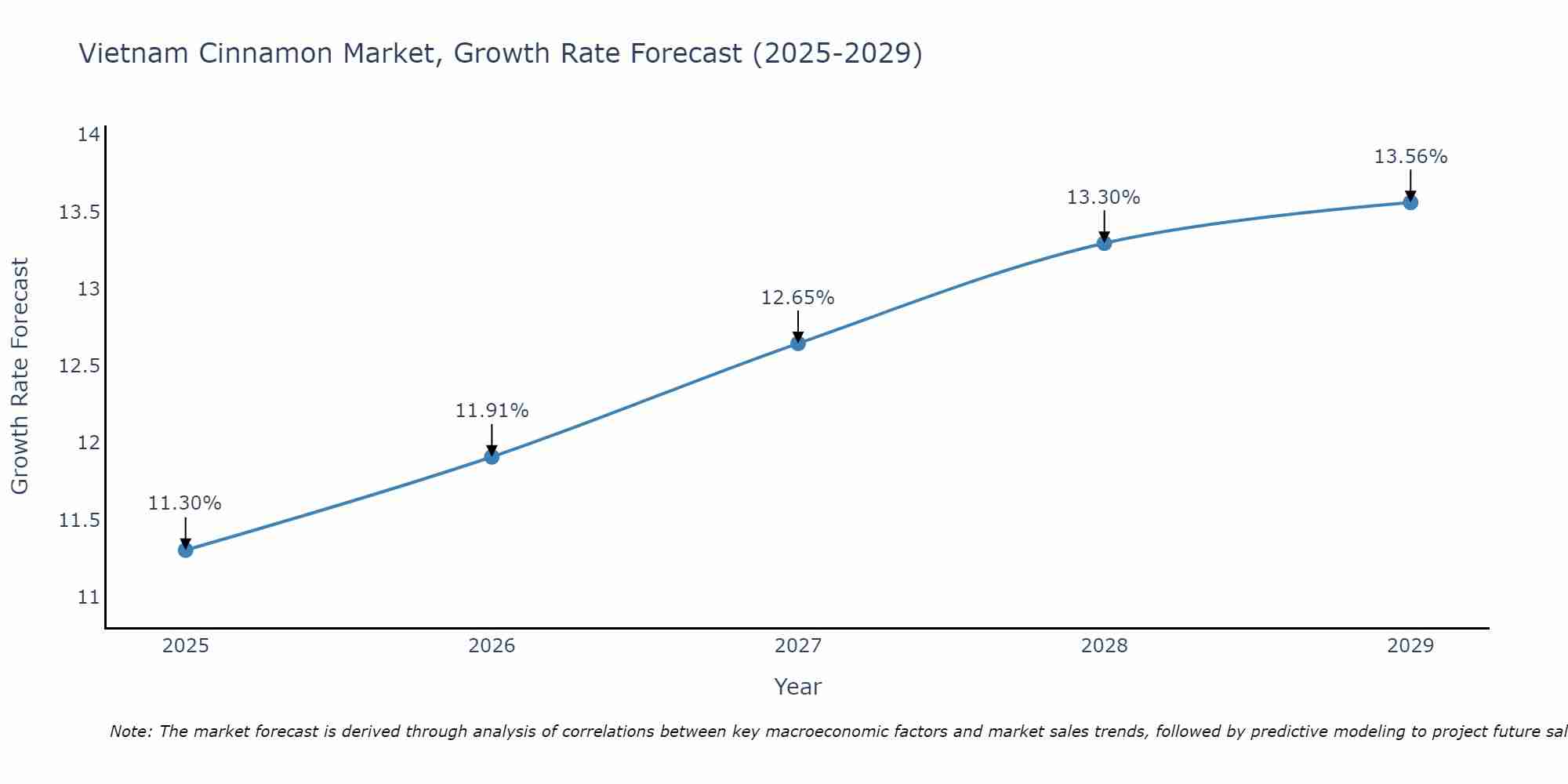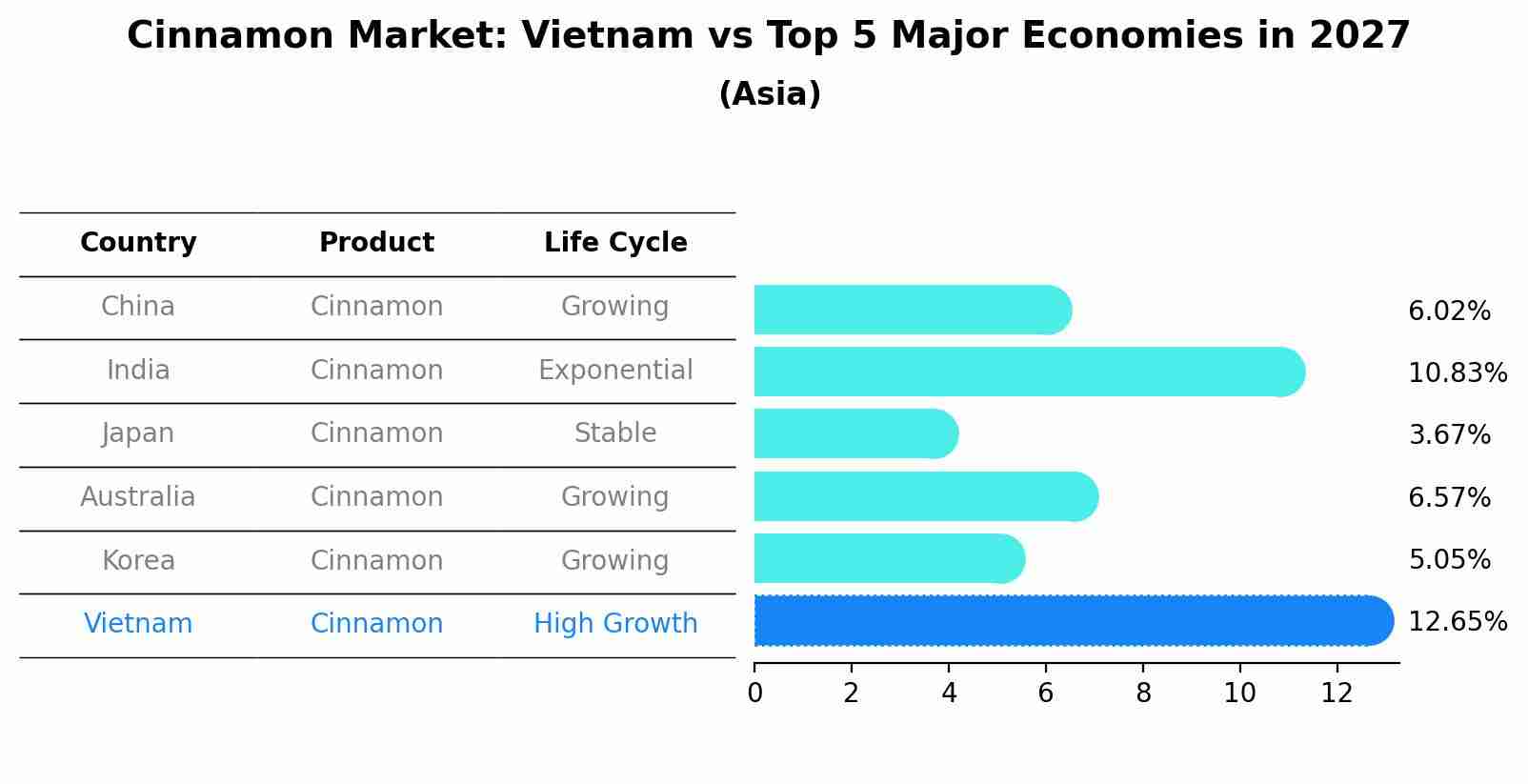Vietnam Cinnamon Market (2025-2031) Outlook | Growth, Industry, Companies, Trends, Share, Forecast, Revenue, Analysis, Value & Size
| Product Code: ETC318690 | Publication Date: Aug 2022 | Updated Date: Aug 2025 | Product Type: Market Research Report | |
| Publisher: 6Wresearch | Author: Ravi Bhandari | No. of Pages: 75 | No. of Figures: 35 | No. of Tables: 20 |
Vietnam Cinnamon Market Size Growth Rate
The Vietnam Cinnamon Market is likely to experience consistent growth rate gains over the period 2025 to 2029. Commencing at 11.30% in 2025, growth builds up to 13.56% by 2029.

Cinnamon Market: Vietnam vs Top 5 Major Economies in 2027 (Asia)
By 2027, the Cinnamon market in Vietnam is anticipated to reach a growth rate of 12.65%, as part of an increasingly competitive Asia region, where China remains at the forefront, supported by India, Japan, Australia and South Korea, driving innovations and market adoption across sectors.

Vietnam Cinnamon Market Synopsis
The Vietnam cinnamon market encompasses the cultivation, processing, and distribution of cinnamon, a popular spice known for its aromatic and flavor-enhancing qualities. Cinnamon is used in various culinary applications and has potential health benefits. In Vietnam, it is primarily cultivated in the northern regions. The market`s performance is influenced by factors such as weather conditions, export demand, and the quality of the cinnamon produced. To succeed in this market, participants must pay attention to these factors and maintain high product quality.
Drivers of the Market
The Vietnam cinnamon market has experienced significant growth driven by several factors. Firstly, cinnamon is a widely used spice in Vietnamese cuisine, making it a staple in households and restaurants. The country`s rich culinary tradition and the preference for flavorful dishes have ensured a consistent demand for cinnamon. Additionally, the export of Vietnamese cinnamon to international markets has seen a boost, as it is recognized for its quality and aroma. Furthermore, the increasing popularity of traditional medicine and herbal remedies has furthered the demand for cinnamon, as it is believed to have various health benefits. Moreover, the agricultural sector in Vietnam has been modernizing and adopting advanced farming practices, leading to increased cinnamon production. As the global demand for spices and natural ingredients continues to grow, Vietnam position as a prominent cinnamon producer is expected to strengthen.
Challenges of the Market
The Vietnam cinnamon market faces challenges related to quality control and market competition. Ensuring the consistent quality of cinnamon products can be difficult, and the market`s competitiveness depends on factors like pricing, supply chain efficiency, and meeting international standards.
COVID-19 Impact on the Market
The Vietnam cinnamon market encountered a mixed bag of challenges during the pandemic. On one hand, as people spent more time at home, the demand for spices, including cinnamon, in cooking and baking increased. However, the disruptions in the supply chain and difficulties in international trade created hurdles for both importers and exporters in the cinnamon market. Additionally, social distancing measures affected the operation of traditional markets where spices are often sold, impacting small-scale producers and traders. Despite these challenges, some businesses in the Vietnam cinnamon market managed to tap into the growing consumer interest in home cooking and baking, leveraging e-commerce and direct-to-consumer channels.
Key Players in the Market
In the Vietnam cinnamon market, companies like SpiceMaster Vietnam, AromaCin, and Natural Flavors Ltd. are well-known for their cinnamon products. They supply cinnamon spice to both the domestic and international markets, meeting the culinary and flavoring needs of consumers.
Key Highlights of the Report:
- Vietnam Cinnamon Market Outlook
- Market Size of Vietnam Cinnamon Market, 2024
- Forecast of Vietnam Cinnamon Market, 2031
- Historical Data and Forecast of Vietnam Cinnamon Revenues & Volume for the Period 2021-2031
- Vietnam Cinnamon Market Trend Evolution
- Vietnam Cinnamon Market Drivers and Challenges
- Vietnam Cinnamon Price Trends
- Vietnam Cinnamon Porter's Five Forces
- Vietnam Cinnamon Industry Life Cycle
- Historical Data and Forecast of Vietnam Cinnamon Market Revenues & Volume By Product for the Period 2021-2031
- Historical Data and Forecast of Vietnam Cinnamon Market Revenues & Volume By Ceylon for the Period 2021-2031
- Historical Data and Forecast of Vietnam Cinnamon Market Revenues & Volume By Cassia for the Period 2021-2031
- Historical Data and Forecast of Vietnam Cinnamon Market Revenues & Volume By Saigon for the Period 2021-2031
- Historical Data and Forecast of Vietnam Cinnamon Market Revenues & Volume By Korintje for the Period 2021-2031
- Historical Data and Forecast of Vietnam Cinnamon Market Revenues & Volume By Application for the Period 2021-2031
- Historical Data and Forecast of Vietnam Cinnamon Market Revenues & Volume By Residential for the Period 2021-2031
- Historical Data and Forecast of Vietnam Cinnamon Market Revenues & Volume By Commercial for the Period 2021-2031
- Vietnam Cinnamon Import Export Trade Statistics
- Market Opportunity Assessment By Product
- Market Opportunity Assessment By Application
- Vietnam Cinnamon Top Companies Market Share
- Vietnam Cinnamon Competitive Benchmarking By Technical and Operational Parameters
- Vietnam Cinnamon Company Profiles
- Vietnam Cinnamon Key Strategic Recommendations
Frequently Asked Questions About the Market Study (FAQs):
1 Executive Summary |
2 Introduction |
2.1 Key Highlights of the Report |
2.2 Report Description |
2.3 Market Scope & Segmentation |
2.4 Research Methodology |
2.5 Assumptions |
3 Vietnam Cinnamon Market Overview |
3.1 Vietnam Country Macro Economic Indicators |
3.2 Vietnam Cinnamon Market Revenues & Volume, 2021 & 2031F |
3.3 Vietnam Cinnamon Market - Industry Life Cycle |
3.4 Vietnam Cinnamon Market - Porter's Five Forces |
3.5 Vietnam Cinnamon Market Revenues & Volume Share, By Product, 2021 & 2031F |
3.6 Vietnam Cinnamon Market Revenues & Volume Share, By Application, 2021 & 2031F |
4 Vietnam Cinnamon Market Dynamics |
4.1 Impact Analysis |
4.2 Market Drivers |
4.2.1 Increasing consumer awareness about the health benefits of cinnamon |
4.2.2 Growth in demand for natural and organic food products |
4.2.3 Rising popularity of Vietnamese cuisine globally |
4.3 Market Restraints |
4.3.1 Fluctuations in cinnamon prices due to supply chain disruptions or weather conditions |
4.3.2 Competition from other spice alternatives |
4.3.3 Challenges in maintaining consistent quality and supply chain management |
5 Vietnam Cinnamon Market Trends |
6 Vietnam Cinnamon Market, By Types |
6.1 Vietnam Cinnamon Market, By Product |
6.1.1 Overview and Analysis |
6.1.2 Vietnam Cinnamon Market Revenues & Volume, By Product, 2021-2031F |
6.1.3 Vietnam Cinnamon Market Revenues & Volume, By Ceylon, 2021-2031F |
6.1.4 Vietnam Cinnamon Market Revenues & Volume, By Cassia, 2021-2031F |
6.1.5 Vietnam Cinnamon Market Revenues & Volume, By Saigon, 2021-2031F |
6.1.6 Vietnam Cinnamon Market Revenues & Volume, By Korintje, 2021-2031F |
6.2 Vietnam Cinnamon Market, By Application |
6.2.1 Overview and Analysis |
6.2.2 Vietnam Cinnamon Market Revenues & Volume, By Residential, 2021-2031F |
6.2.3 Vietnam Cinnamon Market Revenues & Volume, By Commercial, 2021-2031F |
7 Vietnam Cinnamon Market Import-Export Trade Statistics |
7.1 Vietnam Cinnamon Market Export to Major Countries |
7.2 Vietnam Cinnamon Market Imports from Major Countries |
8 Vietnam Cinnamon Market Key Performance Indicators |
8.1 Percentage increase in export demand for Vietnamese cinnamon |
8.2 Number of new product launches incorporating Vietnamese cinnamon |
8.3 Growth in the number of cinnamon farms and plantations in Vietnam |
8.4 Adoption rate of sustainable farming practices in the Vietnamese cinnamon industry |
8.5 Improvement in the quality standards and certifications for Vietnamese cinnamon |
9 Vietnam Cinnamon Market - Opportunity Assessment |
9.1 Vietnam Cinnamon Market Opportunity Assessment, By Product, 2021 & 2031F |
9.2 Vietnam Cinnamon Market Opportunity Assessment, By Application, 2021 & 2031F |
10 Vietnam Cinnamon Market - Competitive Landscape |
10.1 Vietnam Cinnamon Market Revenue Share, By Companies, 2024 |
10.2 Vietnam Cinnamon Market Competitive Benchmarking, By Operating and Technical Parameters |
11 Company Profiles |
12 Recommendations |
13 Disclaimer |
- Single User License$ 1,995
- Department License$ 2,400
- Site License$ 3,120
- Global License$ 3,795
Search
Thought Leadership and Analyst Meet
Our Clients
Related Reports
- Canada Oil and Gas Market (2026-2032) | Share, Segmentation, Value, Industry, Trends, Forecast, Analysis, Size & Revenue, Growth, Competitive Landscape, Outlook, Companies
- Germany Breakfast Food Market (2026-2032) | Industry, Share, Growth, Size, Companies, Value, Analysis, Revenue, Trends, Forecast & Outlook
- Australia Briquette Market (2025-2031) | Growth, Size, Revenue, Forecast, Analysis, Trends, Value, Share, Industry & Companies
- Vietnam System Integrator Market (2025-2031) | Size, Companies, Analysis, Industry, Value, Forecast, Growth, Trends, Revenue & Share
- ASEAN and Thailand Brain Health Supplements Market (2025-2031) | Strategy, Consumer Insights, Analysis, Investment Trends, Opportunities, Growth, Size, Share, Industry, Revenue, Segments, Value, Segmentation, Supply, Forecast, Restraints, Outlook, Competition, Drivers, Trends, Demand, Pricing Analysis, Competitive, Strategic Insights, Companies, Challenges
- ASEAN Bearings Market (2025-2031) | Strategy, Consumer Insights, Analysis, Investment Trends, Opportunities, Growth, Size, Share, Industry, Revenue, Segments, Value, Segmentation, Supply, Forecast, Restraints, Outlook, Competition, Drivers, Trends, Demand, Pricing Analysis, Competitive, Strategic Insights, Companies, Challenges
- Europe Flooring Market (2025-2031) | Outlook, Share, Industry, Trends, Forecast, Companies, Revenue, Size, Analysis, Growth & Value
- Saudi Arabia Manlift Market (2025-2031) | Outlook, Size, Growth, Trends, Companies, Industry, Revenue, Value, Share, Forecast & Analysis
- Uganda Excavator, Crane, and Wheel Loaders Market (2025-2031) | Strategy, Consumer Insights, Analysis, Investment Trends, Opportunities, Growth, Size, Share, Industry, Revenue, Segments, Value, Segmentation, Supply, Forecast, Restraints, Outlook, Competition, Drivers, Trends, Demand, Pricing Analysis, Competitive, Strategic Insights, Companies, Challenges
- Rwanda Excavator, Crane, and Wheel Loaders Market (2025-2031) | Strategy, Consumer Insights, Analysis, Investment Trends, Opportunities, Growth, Size, Share, Industry, Revenue, Segments, Value, Segmentation, Supply, Forecast, Restraints, Outlook, Competition, Drivers, Trends, Demand, Pricing Analysis, Competitive, Strategic Insights, Companies, Challenges
Industry Events and Analyst Meet
Whitepaper
- Middle East & Africa Commercial Security Market Click here to view more.
- Middle East & Africa Fire Safety Systems & Equipment Market Click here to view more.
- GCC Drone Market Click here to view more.
- Middle East Lighting Fixture Market Click here to view more.
- GCC Physical & Perimeter Security Market Click here to view more.
6WResearch In News
- Doha a strategic location for EV manufacturing hub: IPA Qatar
- Demand for luxury TVs surging in the GCC, says Samsung
- Empowering Growth: The Thriving Journey of Bangladesh’s Cable Industry
- Demand for luxury TVs surging in the GCC, says Samsung
- Video call with a traditional healer? Once unthinkable, it’s now common in South Africa
- Intelligent Buildings To Smooth GCC’s Path To Net Zero


















